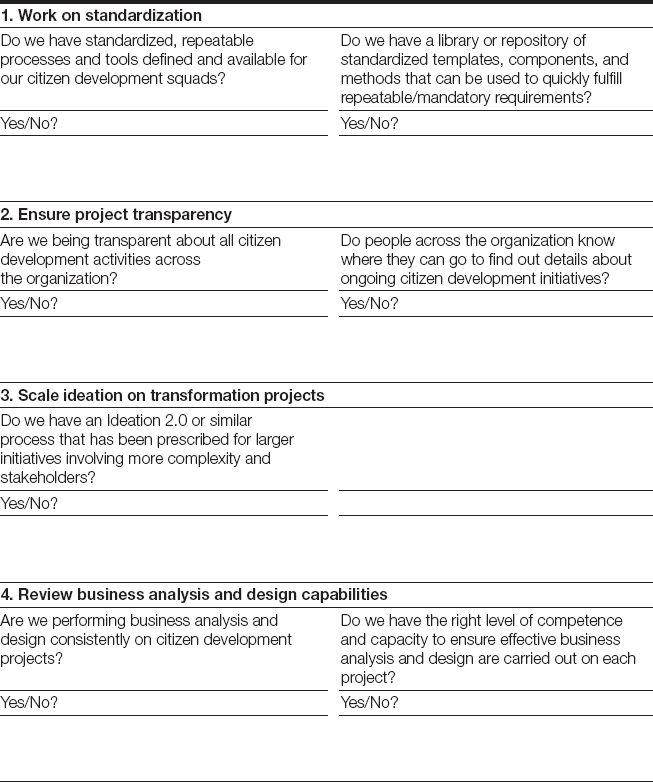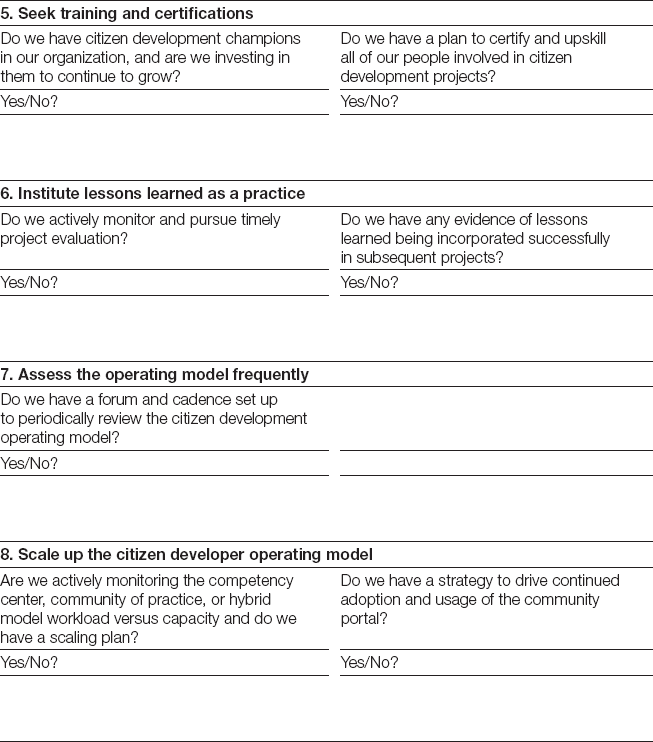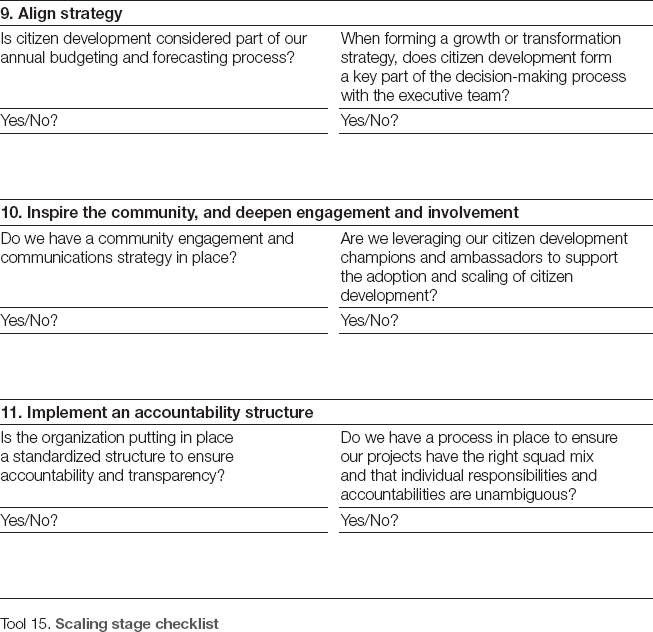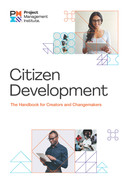| 6.4 Scaling |  |
Lead the citizen development revolution. Your organization has seen the value, and now it's time to bring it across the organization.
At this stage, citizen development is a key value driver, has established elements that foster further benefits, and is creating a culture of innovation.

“Everyone wants to live on top of the mountain, but all the happiness and growth occurs while you're climbing it.”
Andy Rooney
![]()
Overview
Once the organization has proven and formally adopted citizen development, the next stage is all about growth and scaling up activities. At this point, there will be firmly embedded governance bodies to facilitate effective and compliant citizen development across the organization. The competency center, community of practice, or hybrid model have matured and will now be staffed with certified citizen developer practitioners, architects, and strategists. The competency center, community of practice, or hybrid model will continually engage with their counterparts in IT and other parts of the organization—at the operational level through to the C-suite. This will help to keep interest, visibility, and commitment levels high and will be an important means of capturing new use cases for the backlog of projects. In the scaling stage (Figure 26), the repeatable processes and formal structures should be established and able to cater to the increasing demand for citizen development across the organization.
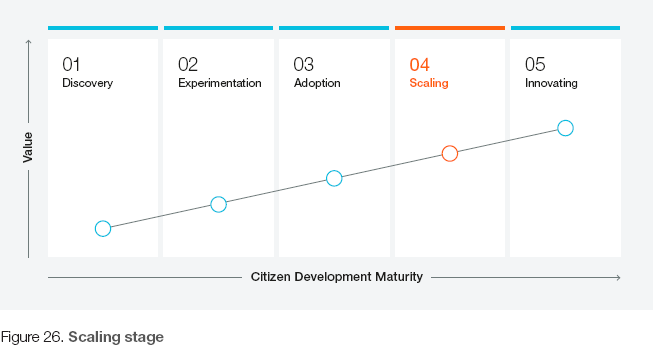
How to recognize the scaling stage
Table 27 outlines the characteristics of the scaling stage for each Canvas component.

Why is the scaling stage important?
•Citizen development becomes a significant value driver for the organization.
•Wide-scale citizen development adoption drives a culture of innovation.
Scaling Stage in Practice
Project delivery
Work on standardization.
As the number of citizen development projects increases, so does the risk that squads will perform redundant work by developing solutions that already exist. For citizen development to be effective, standardization and repeatable processes are essential. The competency center, community of practice, or hybrid model plays an important role in identifying opportunities to standardize. This could be the creation of standardized, reusable components that can be built into apps (e.g., a single sign-on and authentication module preconfigured for the organization or a catalog of brand-approved style templates that citizen development squads can use to build their apps even faster). The citizen developer architect will play a key role in driving forward this standardization agenda, which will directly lead to shorter project durations and consistency across the portfolio of apps in the way common functions are designed and performed.
Standardization can be reached on different levels, such as:
•Standard look and feel (e.g., style sheets, fonts, colors, built-in branding guidelines)
•Standard user interface (e.g., visual cues, screen behavior, common icons, page templates)
•Standardized default functions (e.g., authentication process, web service calls, access to approved data repositories)
•Standardized processes (e.g., suitability test, Ideation 2.0, Hyper-Agile SDLC)
Aside from enhancing the productivity and efficiency of creating apps through citizen development, standardization will also streamline governance processes and reduce manual effort, especially when predefined standardized governance requirements are built into the app-building process. The competency center, community of practice, or hybrid model should focus on creating a library of standard components, automating governance practices as much as possible. Publish the contents and availability in the community portal and update it regularly.
Ensure project transparency.
As important as it is for the individuals on citizen development squads to learn from each project they deliver, it is equally important for the wider community to learn from all projects that are delivered within the organization. This is especially true in this phase of scaling up the efforts in citizen development. Project characteristics, deliverables, results, evaluations, retrospectives, and lessons learned should therefore be available throughout the organization, and success stories should continue to be developed for each project. The obvious way to do this is by publishing this information on the community portal; however, there are also other very effective communication assets that can be used in live events and road shows.
Making this information visible and accessible will also help managers and other stakeholders keep up to speed with all citizen development projects that are in flight in the organization. This transparency breeds trust and promotes more cross-organizational engagement and buy-in.
Scale ideation on transformation projects.
By now, the Ideation 2.0 process, or similar, should be a widely adopted collaborative practice to articulate requirements and build apps. As more increasingly ambitious, transformational initiatives are added to the citizen development backlog of projects, the importance of having a robust, scalable ideation process increases; the stakes are higher, the number of stakeholders involved is higher, and there will be new risks and budget requirements to consider.
Projects will likely impact multiple teams, departments, or even divisions, and changes may be proposed that could have wider-reaching implications for the organization. It is therefore essential to embed a suitable, scalable method, such as Ideation 2.0, to facilitate squads that are designing and building apps rapidly, iteratively, and in collaboration with impacted stakeholders and subject matter experts.
It is important to note that when too many people are involved in the process, its effectiveness can begin to decrease. This can lead to lengthy debates and may stifle new idea suggestions. The focus of discussions might become too low level and outside the domain of expertise of several members of the group. For larger projects where many stakeholders are impacted, it may be worth reviewing the scope of the project to assess whether delivery can be simplified by prioritizing the needs of specific squads, before catering to subsequent sets of stakeholder needs. Alternatively, consider holding multiple Ideation 2.0 sessions with subgroups to focus on specific parts of the proposed solution.
Capability development
Review business analysis and design capabilities.
In the scaling stage, citizen development will be perceived as growing in importance in the organization. Confidence in the ability of the in-house citizen developers to deliver should be increasing as each application goes live and publishes a success story. It is likely that the scale and ambition of new projects added to the citizen development backlog of projects will increase. As new projects are added, it is inevitable that more will be aimed at “cross-border” process transformations.
As the size and complexity of use cases in the backlog increase, the organization needs to consider if its current business analysis, design capabilities, and approach are fit for purpose and if these capabilities reside with the right people. Up until this stage, business analysis and design would have been conducted within the citizen development squad, where the role is performed by someone who might not necessarily have formal training in eliciting requirements or other business analysis methods. The competency center, community of practice, or hybrid model should define what the prerequisite knowledge is and provide suitable training made available via the community portal.
Seek training and certifications.
At this stage of maturity, the organization should have an established competency center, community of practice, or hybrid model and citizen development community focused on enabling and promoting this way of working in the organization. The competency center, community of practice, or hybrid model should be staffed by a certified team that will identify the training needs of the organization, source suitable learning options, and establish the process through which individuals can upskill, either through classroom-based training or e-learning courses accessible via the community portal.
The competency center, community of practice, or hybrid model should be focused on increasing the quality and knowledge of the citizen development squads by providing certifications in citizen development for practitioners, architects, and strategists. Certified citizen developer practitioners will be skilled in turning ideas into apps. They will be very familiar with the tools, methods, and requirements needed for each stage of the SDLC and will be adept at facilitating collaborative Ideation 2.0 workshops.
Certified citizen developer architects will learn how to establish and optimize the citizen development operating model and will be skilled at guiding and steering citizen development squads through the delivery of their projects. Architects can come from either the business or IT. They will understand the needs of the citizen development community and establish the guardrails and ways of working with IT to ensure strict compliance and adherence to the architectural standards and criteria. Architects work with stakeholders across both IT and the business to provide both the context and the boundaries for any prospective citizen developer initiative. They also establish the metrics and reporting of all citizen development activities.
Citizen developer strategists work with senior leadership and the C-suite to establish the principles, practices, and culture that will allow citizen development to flourish. Strategists work with the architects to identify where citizen development is suitable, how to track value, and how to embed the right balance of oversight and decentralized decision making that is key to unlocking greater community-driven innovation.
Institute lessons learned as a practice.
For continued scaling of citizen development in the organization, it is essential that there is a process in place across all initiatives to capture lessons learned. The last thing you would want to do is duplicate and scale up a process that isn't effective and mandate it for all projects. Fortunately, capturing lessons learned is a time-tested project management discipline, and most project squads will see this as part and parcel of executing and closing out their projects. However, it is not uncommon in this stage of scaling up efforts that time becomes an enemy, and citizen development squads decide to deprioritize or postpone their project evaluation to a later time. Unfortunately, there are many cases where lessons learned evaluations are not conducted on projects. It is important to ensure that conducting a lessons learned evaluation is a deeply embedded and rigorously adhered to practice across all citizen development projects.
Operating model
Assess the operating model frequently.
In the adoption stage, the operating model was formalized and put in place. The effort didn't stop there, as the operating model will keep evolving as maturity progresses. In this stage of maturity, two important things happen:
•Number of citizen development projects rapidly increases
•Nature of projects gradually shifts from largely local changes to enterprise transformations
Both of these have an impact on the operating model. The increase in scale will require different ways for people to work together efficiently. With higher volumes of projects, it will be important to review the capacity and availability of skilled or certified individuals to support the process. Stakeholders need to be aligned differently and may be involved in several projects at the same time. Governance requirements will likely evolve or change as a result, as will many other aspects of the structures that have been put into place.
Organize periodic reviews of the operating model, e.g., quarterly or bimonthly, to ensure the structures, processes, and governance required to support the ongoing scaling of citizen development are in place and are fit for purpose. Inputs such as lessons learned and direct feedback from involved stakeholders, IT, and senior management are key.
It will be the responsibility of the competency center, community of practice, or hybrid model to ensure that the operating model is fit for purpose. The architect is the typical role that is responsible for ensuring this; however, this responsibility can also be assigned to the strategist, depending on the organization and the scale of the model.
Scale up the citizen development operating model.
Organizations come in all shapes and sizes. Some are going to be more traditional and hierarchical, with an operating model that promotes compliance and risk aversion. Others devolve decision making and have structures that promote speed and agility. The organization's configuration will have an influence on the optimum structure of the competency center, community of practice, or hybrid model. For instance, in the traditional hierarchical structures that operate in slow-changing, commoditized markets, a large, static, colocated competency center might be an appropriate (and culturally acceptable) construct to help centralize and support the execution and scaling of citizen development. However, there are many organizations with geographically diverse teams that operate in fast-changing markets, which requires an operating model that promotes organizational agility and devolved decision making. In these organizations, a decentralized, virtual community of practice might be more acceptable and fit for purpose.
Organization alignment
Align strategy.
As citizen development is fully adopted into the organization in this stage, it needs to be considered as part of all strategic decisions made by the executive(s). At the most basic level, the citizen developer strategist would be working to ensure that citizen development is strategically aligned with IT when completing the annual IT budgeting process, which provides an alternative channel through which to develop new technology solutions, or when considering the organization's 3-year plan or transformation strategy. Citizen development needs to be core to any strategic investment decisions in terms of the value it delivers and the capacity it requires.
Inspire the community, and deepen engagement and involvement.
Community engagement continues to be a vital element in the scaling stage of citizen development. By now, citizen development is a well-understood and proven way of working that has yielded well-publicized value and solutions across the organization. The competency center, community of practice, or hybrid model is firmly embedded and the certified practitioners, architects, and strategists in the organization have established the tools, processes, and ways of working that facilitate effective citizen development and encourage further adoption. It is important, however, to continue building on the momentum through sustained community engagement.
Citizen development should be kept in the limelight through regular events, both formal and informal. Hackathons, lunch and learns, external speaker events, competitions, and public recognition will continue to generate excitement and involvement. A social media campaign that publicly celebrates the value being generated for the organization is another mechanism for the organization's community to feel their efforts are being recognized. Identify the citizen developer champions—the ambassadors of citizen development who can work to drive wide-scale adoption at the grassroots level. Empower and reward champions and use them in your public relations and communications efforts. At internal and external events, recruit the champions as floor walkers to encourage colleagues to explore citizen development.
Implement an accountability structure.
Though citizen developers will already feel a large responsibility toward their projects in this stage, it is important to formalize the accountability of each role on the squad. A solid structure that shows who is responsible for what creates clarity to the citizen development squad and any other stakeholders involved in the project. Stakeholders should be clear on what is expected of them and also what is not. This prevents multiple roles from taking responsibility for the same subject, potentially creating conflicts of interest and duplicating effort.
The implementation of an accountability structure using tools such as a RACI matrix or stakeholder matrix will create the required transparency of individual squad members’ responsibilities to ensure squads are optimally set up.
Key roles and responsibilities
Note that it is likely that these roles may be part of someone's existing role and may have different titles. What's important is that these activities are performed by people within the organization. Table 28 describes the responsibilities relating to each citizen development role in the scaling stage.
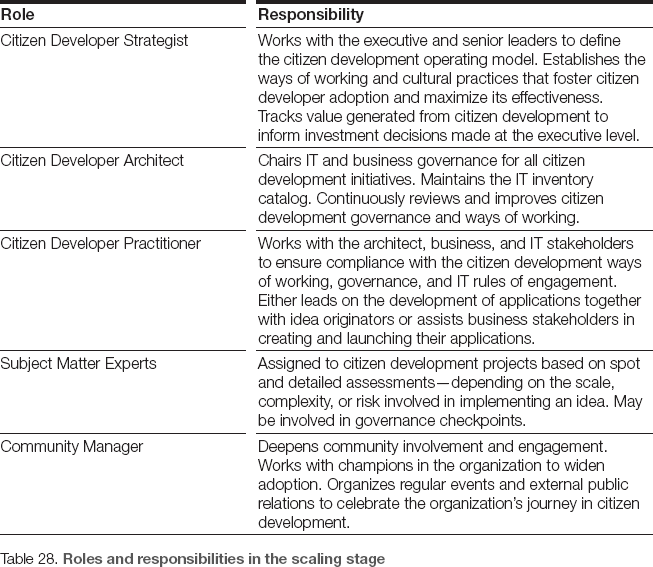
Summary Checklist for the Scaling Stage
Tool 15 is a checklist of questions that squads should answer as they move through the scaling stage.
